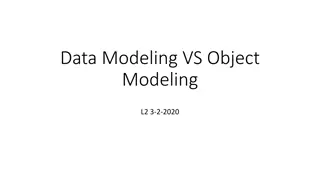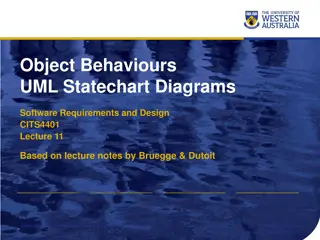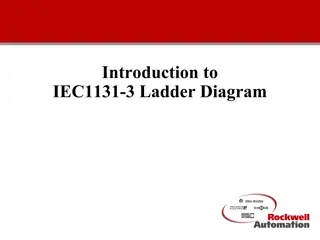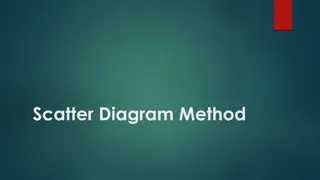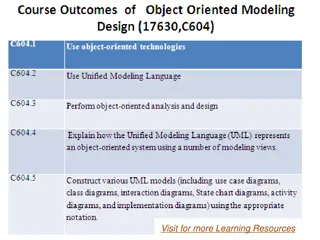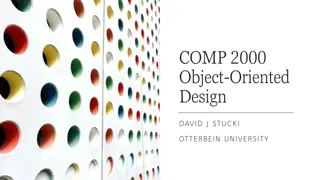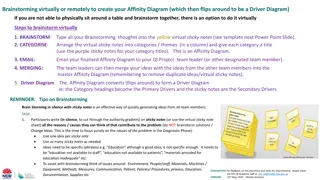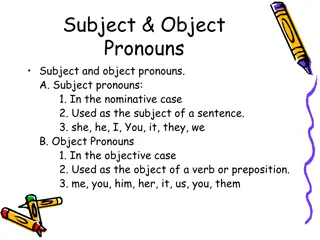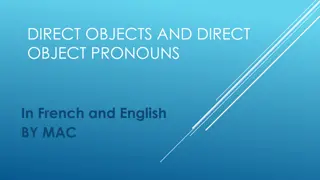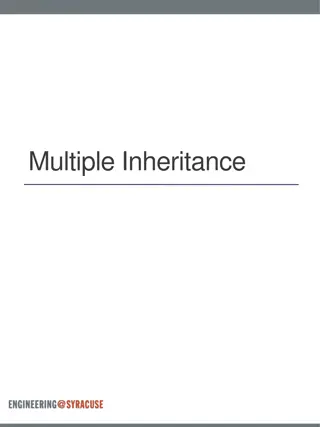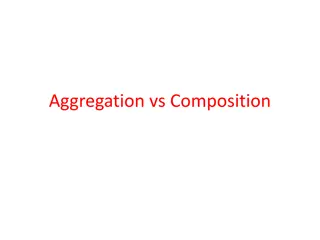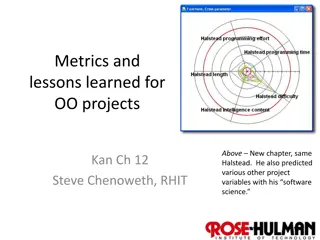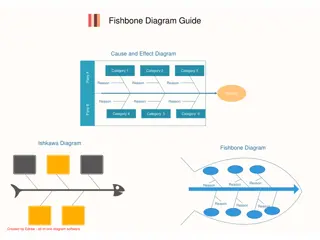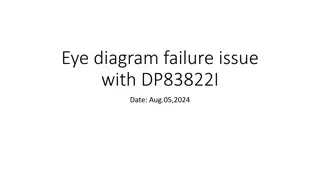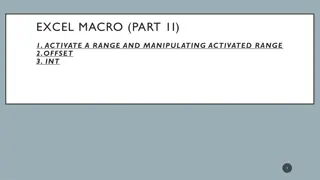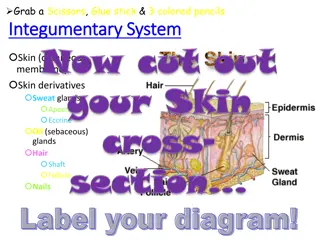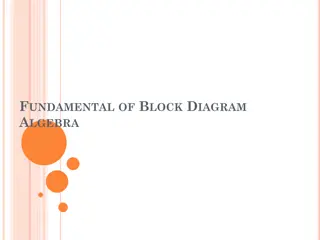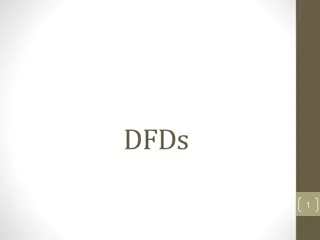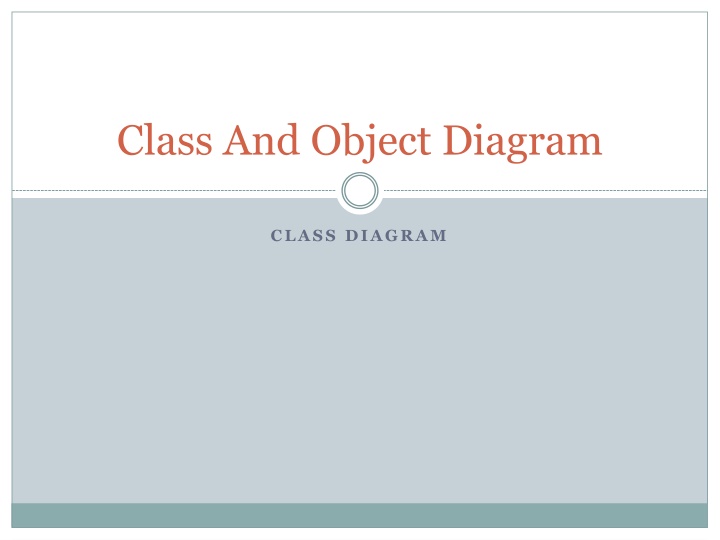
Class Diagrams in Software Development
Explore the significance of class diagrams in software development, identifying classes through use cases, interpreting relationships, attributes, and more. Enhance your understanding of class relationships, inheritance, and the role of boundaries in system development.
Download Presentation

Please find below an Image/Link to download the presentation.
The content on the website is provided AS IS for your information and personal use only. It may not be sold, licensed, or shared on other websites without obtaining consent from the author. If you encounter any issues during the download, it is possible that the publisher has removed the file from their server.
You are allowed to download the files provided on this website for personal or commercial use, subject to the condition that they are used lawfully. All files are the property of their respective owners.
The content on the website is provided AS IS for your information and personal use only. It may not be sold, licensed, or shared on other websites without obtaining consent from the author.
E N D
Presentation Transcript
Class And Object Diagram CLASS DIAGRAM
classes were not identified systematically. Because we have now gone through the processes of business requirements modeling and system requirements modeling, we have a good source of candidate classes in the form of system use cases. Candidate classes are often indicated by nouns in the use cases.
A class diagram shows us what classes exist and how they re related. (Officially, class diagrams can also show attributes and operations, but that requires a lot more space.) In the case of aggregation, composition and association, the class diagram shows permitted run-time relationships rather than actual ones. Relationships between classes are shown as lines with various annotations. Even without particular knowledge of UML, its easy to pick information out of a class diagram, just from the text. Although the relationships on a class diagram are usually drawn between classes, the run-time relationship is actually between objects
Attributtes An attribute is a property of an object, such as its size, position, name, price, font, interest rate, or whatever. In UML, each attribute can be given a type, which is either a class or a primitive. If we choose to specify a type, it should be shown to the right of the attribute name, after a colon. (We might choose not to specify attribute types during analysis, either because the types are obvious or because we don t want to commit ourselves yet.) Attributes can be shown on a class diagram by adding a compartment under the class name. To save space, we can document them separately instead as an attribute list, complete with descriptions. If we were using a software development tool, we would expect to be able to zoom in to see attributes (and their descriptions) or zoom out to see class names only. If you can t provide a short description for an attribute at this stage, perhaps it should be several attributes, or even a class in its own right.
The system itself, for example, system or iCoot: As far as were concerned, the system is just a boundary for the development effort. Actors, for example, Assistant or Head Office: An exception to this is when we need to store information about an actor internally (for example, for Member, we need to store a password). Most of the time, actors are anonymous driving forces for our boundaries. Boundaries, for example, customer applet or head office link : At this stage, we re trying to identify business-related objects with interesting information and behavior. Boundaries are particular pieces of software that allow actors to get at our objects. Trivial types (for example, strings and numbers): We can assume that these will be provided by the implementation language or its libraries.
Class relationships Inheritance: A subclass inherits all of the attributes and behavior of its superclass(es). Association: Objects of one class are associated with objects of another class. Aggregation: Strong association an instance of one class is made up of instances of another class. Composition: Strong aggregation the composed object can t be shared by other objects and dies with its composer. Inheritance is a different kind of relationship to the other three: inheritance describes a compile-time relationship between classes while the others describe a run-time connection between objects. According to the UML standard, all run-time relationships come under the umbrella term association. However, most people use the term association to mean an association that isn t aggregation or composition . Choosing between relationships can be tricky you need to use intuition, experience and guesswork. During analysis, you should expect the frequency of these kinds of relationship to be: association > aggregation > inheritance > composition
Drawing relationships shows how inheritance is depicted on a class diagram: a white filled arrowhead on a solid line is drawn from the subclass to the superclass. hierarchies of subclasses, the arrows can be combined in the style shown on the left. Thus, SportsCar and Saloon are both subclasses of Car. In order to emphasize
Associations Classes Occasionally, an association has some information or behavior related to it. An association class can be introduced alongside the association, For each link, there is a corresponding Reservation object that has a number, time-stamp and state. There is no name given to the association in this case, because it is implicit in the name of the association class. An association class represents operations that exist only because the association exists: the attributes and operations are not tied to the objects at either end of the association. attributes and
Aggregation is drawn as a line between two classes with a white diamond on the aggregator s end. Composition is drawn in a similar way to aggregation, but with a black diamond on the composer s end. Association is shown as an undecorated line. Thus, a Driver is associated with a Car, but the Driver is not part of the Car (that would be aggregation) and the Driver is not always part of a single Car (that would be composition).
Multiplicity All relationships except inheritance can indicate at either end the number of run-time objects that are allowed to take part in the relationship (the multiplicity of the relationship): n: Exactly n. m..n: Any number in the range m to n (inclusive). p..*: Any number in the range p to infinity. *: Shorthand for 0..*. 0..1: Optional. For composition, the multiplicity at the composer s end is always because, according to the UML rules, a composed object can t be shared among composites thus a multiplicity would be redundant in this case. In other cases, if no multiplicity is shown, we must assume that it has not been specified, or that it is simply not known at this stage. It would be wrong assume that a missing multiplicity implied some default value, such as 1. 1
Associations, Labels and Comments All relationships, except inheritance, can be given an association label, indicating the nature of the association. If it s not obvious which way the association name should be read, a black arrowhead can be used. As well as association names, we can show roles. A role indicates the part played by an object in the association the role is shown as a label near the object that plays the role. nprinciple, association names and roles can be combined on the same association, but most of the time they should be considered alternatives (in order to avoid clutter). UML comment, an arbitrary piece of text enclosed in an icon that looks like a piece of paper, connected to the relevant part of the diagram by means of a dashed line. If the target of the dashed line is unclear, we can put a small white circle with a black border at the end this is useful when the target is another dashed line, for example. A comment, which can appear on any diagram, can be used to provide extra information that would be difficult or messy to show using other UML notation.
Adding operations to class Every corresponds to an operation on a class, so we should record the operations in order to have a complete set of use case realizations. Operations can be shown on a class diagram in a separate compartment below the attribute Compartment. message on a communication diagram
Abstract class An abstract class is a class with at least one abstract method the abstract method may be introduced on the class itself, or it may be inherited from a superclass. Abstract classes have the following advantages: They permit richer and more flexible modelings They lead to more code sharing, because we can write concrete methods that use abstract methods;
Visibility The visibility of a field specifies which pieces of code are allowed to read or modify the value. The following visibilities are enough for most purposes: Private (shown by - in UML): Only visible within the defining class. Package (shown by in UML): Visible within the defining class and to all classes in the same package. Protected (shown by # in UML): Visible within the defining class, to all classes in the same package, and to all subclasses of the defining class (whether inside or outside the package). Public (shown by + in UML): Visible everywhere.
Package The UML concept of a package allows us to group related classes. The package diagram in Figure 9.10 shows each package as a box with a tab at the top left corner. The package name appears in bold, either in the middle of the box or, if we want to show the contents of the package, inside the tab. The contents of a package can be classes or other packages. In sample, also shows a dependency (the dashed open-ended arrow) from one package to another: the implication is that the source package uses something inside the target package. So far, we ve discussed what could be referred to as the constituent pieces of a package diagram: Package notation Element visibility Dependency relationship
A package can be used to represent: a layer a subsystem a reusable library a framework classes that should be deployed together
Classes and objects are separate yet intimately related concepts. Specifically, every object is the instance of some class, and every class has zero or more instances. For practically all applications, classes are static; therefore, their existence, semantics, and relationships are fixed prior to the execution of a program. Similarly, the class of most objects is static, meaning that once an object is created, its class is fixed. In sharp contrast, however, objects are typically created and destroyed at a furious rate during the lifetime of an application. Although UML allows us to mix classes and objects on the same diagram, people generally use the term class diagram if there are no objects and object diagram if there are no classes (it s up to you what you call a diagram that has both).
Object Diagrams An object diagram is used to show the existence of objects and their relationships in the logical design of a system. Stated another way, an object diagram represents a snapshot in time of an otherwise transitory stream of events over a certain configuration of objects. Object diagrams are thus prototypical each one represents the structural relationships that may occur among a given set of class instances. In this sense, a single object diagram represents a view of the object structure of a system. During analysis, object diagrams are often used to indicate the semantics of primary and secondary scenarios that provide a trace of the system s behavior. During design, object diagrams are often used to illustrate the semantics of mechanisms in the logical design of a system. Regardless of the development phase, object diagrams present concrete examples that assist in the visualization of the associated class diagrams. The two essential elements of object diagrams are objects and their relationships.
Object Diagrams Similar to class diagrams, a horizontal line partitions the text inside the icon into two regions, one denoting the object s name and the other providing an optional view of the object s attributes and their values. Here, though, we see a tool-specific implementation that does not use a horizontal line to completely partition the two regions. Object diagrams are useful for illustrating a particular run-time scenario, but they re optional. For clarity, we would prefer to avoid putting classes and objects on the same diagram. objectName Object name only :ClassName Object class only objectName :ClassName Object name and class
Weve discussed objects and their relationships, which constitute the essential parts of the notation for object diagrams. However, a number of particularly knotty development issues require slightly more than this basic notation. As we warned in our discussion on class diagrams, we must again emphasize that these advanced features should be applied only as necessary to capture the intended semantics of a scenario. Using the same representation as for class diagrams, additional notations that we may represent on object diagrams include constraint, keyword label, navigation, and link name.

